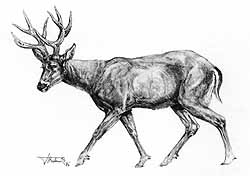English: Marsh Deer; French: Blastocère; Brazilian: Veado galheiro; Guarani: guazú-pucú; Spanish: Ciervo de los pantanos, guazuncho.
 |
Former distribution: Central South America; Brazil, Bolivia, Peru, Paraguay, Uruguay and Argentina.
Present distribution: Mato Grosso in Brazil, eastern Bolivia, Peru, Paraguay along the rivers, Argentina along the Parana river, Uruguay in some northern areas (probably extinct).
Behaviour: Preferred habitat: tall grassland, seasonal flooded areas, marshlands near swamps and water courses; they live in pairs or in small herds of 3 to 6, and feed on reeds, aquatic plants, herbs and grasses; activity diurnal and at twilight. Predators are dogs and caimans.
Population status: Vulnerable. Total numbers: no records. Brazil: 2000; Bolivia: stable; Peru: 200; Paraguay: rare; Argentina: rare; Uruguay: probably extinct.
Brief notes:
Body weight: 100-120 kg
Head and body length: 145-200 cm
Tail length: 25 cm
Shoulder height: 100-115 cm
Gestation period: 9 months
Maximum age: No records
Trophy: No records.
Hunting methods: Hunting is prohibited; formerly by stalking or on horseback. Marsh Deer are protected by law.
Remarks: The populations have diminished considerably due to uncontrolled hunting and the loss of habitat to agriculture and livestock. Good protection is guaranteed on several private ranches. More information required on behaviour, habits and distribution.







